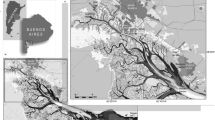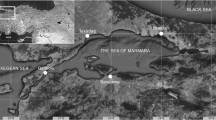Abstract
Protecting wetlands from environmental pollution has been of significant importance, as they are the vital habitats for various kinds of birds and animals. This study has aimed to monitor the contamination of Cd and Pb in Anzali wetland, located in the north of Iran using a mussel biomonitor. The contents of Cd and Pb were measured in the surface sediment, the soft tissue, and the shell of A. cygnea. The samples were collected from four sites in the region. The results demonstrated that the shell of A. cygnea can be employed as a precise case for biomonitoring of Cd and Pb, due to the higher biota-sediment accumulation factor and the lower coefficient of variation values found in the shell compared with the soft tissue, and also according to the positive correlation between Cd and Pb levels in the shell of A. cygnea and the sediment.



Similar content being viewed by others
References
Alyahya H, El-Gendy AH, Al Farraj S, El-Hedeny M (2011) Evaluation of heavy metal pollution in the Persian Gulf using the clam Meretrix Linnaeus, 1758. Water Air Soil Pollut 214:499–507
Bartolome L, Navarro P, Raposo JC, Arana G, Zuloaga O et al (2010) Occurrence and distribution of metals in mussels from the Cantabrian Coast. Arch Environ Contam Toxicol 59(2):235–243
Franklin EB, Yap CK, Ahmad I (2010) Bioaccumulation and distribution of heavy metals (Cd, Cu, Fe, Ni, Pb and Zn) in the different tissues of Chicoreus capucinus lamarck (Mollusca: Muricidae) collected from Sungai Janggut, Kuala Langat, Malaysia. Environ Asia 3(1):65–71
Peer FE, Safahieh A, Sohrab AD, Tochaii SP (2010) Heavy metal concentrations in rock oyster Saccostrea cucullata from Iranian coasts of the Oman Sea Trakia. J Sci 8:79–86
Rafiei B, Ahmadi Ghomi F, Ardebili L, Sadeghifar M, Khodaparast Sharifi HD (2012) Distribution of metals (Cu, Zn, Pb, and Cd) in sediments of the Anzali Lagoon, north of Iran. Soil Sediment Contam 21:768–787
Ravera O, Sprocati AR (1997) Population dynamics, production, assimilation and respiration of two freshwater mussels: Unio mancus, Zhadin and Anodonta cygnea Lam. Mem Ist Ital Idrobiol 56:113–130
Riahi AR, Fazeli MSh, Paydar M (2004) Determination of heavy metal content in Astacus leptodactylus caspicus of Anzali wetland, Iran. Korean J Ecol 27(1):15–20
Rosińska B, Chojnacki JC, Lewandowska A, Matwiejczuk A, Samiczak A (2008) Biometrics of swan mussels from chosen lakes in the Pomeranian Region. Limnol Rev 8(1–2):79–84
Sadeghia R, Zarkamib R, Sabetraftarb K, Dammea PV (2012) Use of support vector machines (SVMs) to predict distribution of an invasive water fern Azolla filiculoides (Lam.) in Anzali wetland, southern Caspian Sea, Iran. Ecol Model 244:117–126
Salahshur S, Riyahi Bakhtiari A, Kochanian P (2012) Use of Solen brevis as a biomonitor for Cd, Pb and Zn on the intertidal zones of Bushehr-Persian Gulf, Iran. Bull Environ Contam Toxicol 88:951–955
Shirneshan G, Riyahi Bakhtiari A (2012) Accumulation and distribution of Cd, Cu, Pb, and Zn in the soft tissue and shell of oysters collected from the northern coast of Qeshm Island, Persian Gulf, Iran. Chem Speciat Bioavailab 24(3):129–138
Tomazelli AC, Martinelli LA, Avelar WEP, de Camargo PB, Fostier A, Ferraz ESB et al (2003) Biomonitoring of Pb and Cd in two impacted watersheds in southeast Brazil, using the freshwater mussel Anodontites trapesialis (Lamarck, 1819) (Bivalvia: Mycetopodidae) as a biological monitor. Braz Arch Biol Technol 46:673–684
Yap CK, Cheng WH (2013) Distributions of heavy metal concentrations in different tissues of the mangrove snail Nerita lineate. Sains Malays 42(5):597–603
Yap CK, Ismail A, Tang SG, Rahim Ismail A (2003) Can the shell of the green-lipped mussel Perna viridis from the west coast of Peninsular Malaysia be a potential biomonitoring material for Cd, Pb and Zn. Estuar Coast Shelf Sci 57:623–630
Yap CK, Ahmad I, Tan SG (2004) Heavy metal (Cd, Cu, Pb and Zn) concentrations in the green-lipped mussel Perna viridis (Linnaeus) collected from some wild and aqua cultural sites in the west coast of Peninsular Malaysia. Food Chem 4:569–575
Yap CK, Noorhaidah A, Azlan A, Ismail A, Siraj SS, Tan SG (2009) Telescopium as potential biomonitors of Cu, Zn, and Pb for the tropical intertidal area. Ecotoxicol Environ Saf 72:496–506
Acknowledgments
We are grateful to express our deepest appreciation to Mr. Ghorbani for his valuable help during the sampling operations.
Author information
Authors and Affiliations
Corresponding author
Rights and permissions
About this article
Cite this article
Ganjali, S., Mortazavi, S. The Swan Mussel (Anodonta cygnea) in Anzali Wetland of Iran, a Potential Biomonitor for Cd and Pb. Bull Environ Contam Toxicol 93, 154–158 (2014). https://doi.org/10.1007/s00128-014-1317-3
Received:
Accepted:
Published:
Issue Date:
DOI: https://doi.org/10.1007/s00128-014-1317-3




